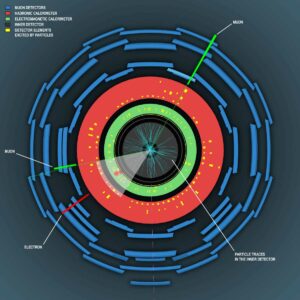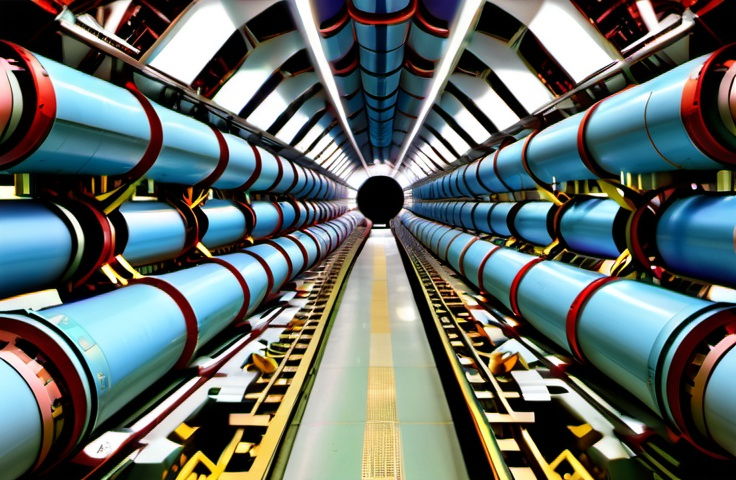Physicists from the European Organisation for Nuclear Research (CERN) have released the results of their ongoing hunt for ‘new physics” using the powerful Large Hadron Collider (LHC).
While no direct evidence for physics beyond the Standard Model was found, the team says their analysis offered valuable constraints for the ongoing hunt that will inform upcoming experiments after the facility undergoes scheduled upgrades, including more powerful beams.
Built over the course of a decade from 1998 to 208 and at a total cost of over nine billion dollars, the Large Hadron Collider in Geneva, Switzerland, brought together over 10,000 scientists from over 100 countries to create one of the most complex and expensive scientific instruments ever made. Responsible for several breakthroughs, the LHC is most famous for discovering the elusive Higgs boson in 2012. At that time, the Higgs boson, which gives other particles mass, was the final piece of the Standard Model of physics yet to be discovered.
According to the facility’s website, “When the universe began, no particles had mass; they all sped around at the speed of light. Stars, planets, and life could only emerge because particles gained their mass from a fundamental field associated with the Higgs boson.”
While overjoyed at the particle’s discovery, the physics community had hoped that along with the confirmation of Higgs, the LHC would also uncover signs of “new physics” operating outside the Standard Model. Unfortunately, according to a statement announcing the latest study, scientists at the facility have found a disappointingly “persistent absence of any trace of physics beyond this model.”
Undaunted by those failures, the researchers at the facility’s ATLAS detector decided to comb through the archives of previous experiments to see if they could detect the creation of a Higgs boson pair using new techniques. While these events are predicted by the Standard Model, popular new physics theories expect them to occur much more often. In fact, according to the statement announcing the study, the creation of a Higgs boson pair is so rare that CERN scientists have yet to witness a single event.
“In proton collisions at the LHC, Higgs bosons appear so infrequently that so far not a single event of Higgs boson pair production has been detected, which at first glance seems absolutely necessary if we want to look at interactions between these particles,” explained Dr. Bartlomiej Zabinski, a physicist at the Institute of Physics of the Polish Academy of Sciences (IPJ PAN) and the leader of the new study effort.
“How, then, can we study a phenomenon that has not yet been observed?” Zabinski asked.
According to the published study, the researchers started with physics simulation software to generate simulated Higgs boson creation events, including events resulting in the creation of Higgs boson pairs. Next, the team took the signals representing the simulated events that culminated in Higgs boson pairs and “normalized” them “according to the expected amount of data coming from their detector.”
After their simulations were completed, the new physics hunters compared their results to the actual data recorded by the LHC to see if they could find signals matching their simulated ones. Given the vast amount of data and the rarity of the predicted events, the team employed machine learning techniques that sorted millions of data points using customized decision trees, which would take humans years to do by hand.
Following the exhaustive search, the team said their machine learning protocols found no signals matching their predictions. Specifically, they found nothing to indicate the existence of new physics.
“So far, we have not noticed anything in the data from our detectors that disagrees with the Standard Model.,” Zabisnki said.


Fortunately, the team says that their effort was not in vain. While no events were detected, their work did offer valuable data that will inform and constrain upcoming experiments looking for new physics.
“This result does not rule out the possibility of the existence of ‘new physics’ phenomena,” Zabinski explained, “but only informs us that their possible influence on the production of Higgs boson pairs remains too weak to be seen in the data collected so far.”
Moving forward, the researchers say the LHC facility is scheduled to undergo significant upgrades in the coming years. Among the most significant is an increase in the intensity of the proton beams used to generate article collisions, which is expected to result in significantly more collisions for each experiment. When looking for an event as rare as the creation of a Higgs boson pair, the more collisions, the better.
“The limitations imposed by the current analysis on the production and parameters describing the interactions of Higgs bosons allow physicists to hope that perhaps already at the beginning of the next decade, it will be possible to select the first events of double Higgs production from more data and to verify today’s predictions in direct observations of the phenomenon,” the statement concludes.
The study “Search for non-resonant Higgs boson pair production in final states with leptons, taus, and photons in pp collisions at = 13 TeV with the ATLAS detector” was published in the Journal of High Energy Physics.
Christopher Plain is a Science Fiction and Fantasy novelist and Head Science Writer at The Debrief. Follow and connect with him on X, learn about his books at plainfiction.com, or email him directly at christopher@thedebrief.org.

